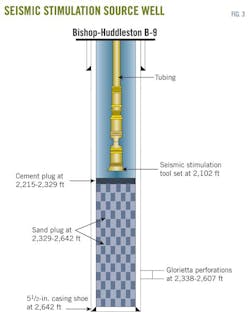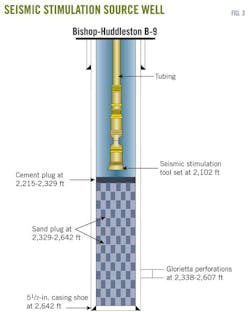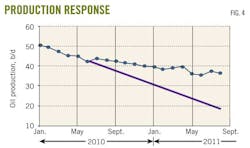P. 4 ~ Continued - Seismic stimulation improves production from West Texas carbonate
Displaying 4/5
View Article as Single page
Lower Clearfork reservoir
The Sharon Ridge Clearfork reservoir in this area has eight dolomite zones (Lower Clearfork) between 3,100 and 3,300 in the Bishop A No. 7 well. Each zone correlates fairly well on neutron logs and generally consists of thin 15-ft intervals with good neutron porosity often separated by 1-5 ft intervals of poor porosity.
Sample and good core shows generally occur in these intervals and previous operators generally chose to perforate them. The intervals typically appear thicker and less interbedded with poorer porosity than the 2,400-ft zones.
The wells on the east half of Section 162 are more recent (1970s), and almost all have all of the porosity from Zone 2 down to Zone 9 drilled and perforated. Although most of these wells produced about 50% water on initial test, some tested oil at good rates with only a small amount of water, further supporting the theory that many porosity intervals in these zones are isolated both laterally and vertically.
Reservoir analysis
In this area, only sparse reservoir data are available. Most Sharon Ridge well logs are cased hole logs, making quantitative log analysis difficult if not impossible. Fortunately, the area has several whole core analyses available that have proven helpful in lithology and reservoir description. The area has only basic reservoir fluid data and no reservoir pressure data available. As mentioned previously, the Glorietta interval is a dolomite with interspersed anhydrite and sand layers. The best reservoir properties occur in the sand layers, where porosities range from 13 to 20% and permeabilities are as high as 10 md.
The dolomitic intervals are dense and tight with average porosities about 13% and average permeabilities of less than 1 md.
The Lower Clearfork is a dense, tight dolomite with some anhydrite inclusions and no sand layers. Core and sample descriptions commonly report vugs with some fracturing observed. Both the Clearfork and the Glorietta require hydraulic fracturing for commercial production rates.
Installation
The seismic stimulation used the inactive Bishop-Huddleston B-9 well as the source well because of its central location in the field; Fig. 3 shows the well completion.
Note that the seismic stimulation tool is completely isolated from the formation with no direct hydraulic connection. This is a typical installation of the tool.
The shockwaves pass through the cement plug and sand with minimal losses in power, but isolation from the formation guarantees that no foreign matter or gas will enter the tool and cause problems.
On firing the shockwaves pass through the cement plug and sand fill before exiting the perforations in the Glorietta at 2,338-2,607 ft.
Simulation results
Fig. 4 shows the results of seismic stimulation on the Bishop-Huddleston lease.
Seismic stimulation improved oil production by 17 b/d, which as of August 2011 equates to an estimated increase in oil recovery of 4,100 bbl.
ASR expects to see the same results in other formations and highly fractured fields with horizontal wells having multiple fractures that due to complex heterogeneities would have in waterflooding early watering out of producing wells.
Displaying 4/5
View Article as Single page


